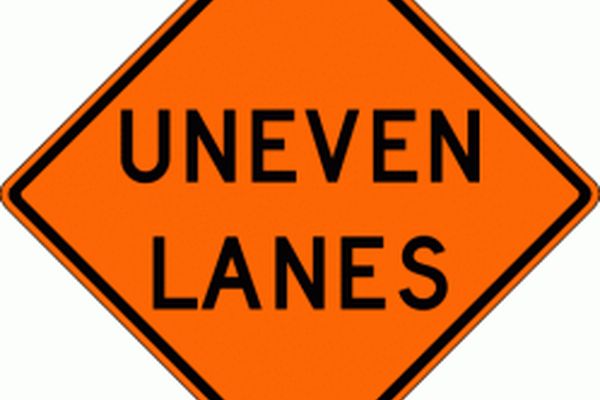
What Does Uneven Lanes Mean? (FDOT Uneven Lanes Sign)
Some road signs may have you scratching your head and wishing you had taken that advanced degree in college. But the uneven lane sign is very clear and leaves little to the imagination.
The uneven lane sign means exactly what it says. One lane is higher in elevation than the ones next to it. The sign could be put up for paving or when the road crews are removing asphalt, etc to redo the roads.
To learn more about this topic, just continue to read our article. It has the information you want to know about so you can be prepared the next time you see these signs. However, sometimes the signs are left up after paving and are useless.
What do Uneven Lanes Mean?

The general rule of thumb, no matter which state you are in, for these signs is to tell you that one lane is higher than another. The difference may be as great as 3 inches or as low as 1 1/2 inches. It just depends on the construction crew and how they work.
If the edge is going to be greater than 1 1/2 inches, then the pavement is to be sloped to make the lane transition smooth. Then, because one lane is paved at a time, the construction crews are supposed to put up signs to warn motorists of the uneven nature of the road.
The only time these signs are supposed to be put up is when paving is going on or when the road crews are stripping asphalt from one lane to improve it. They are also supposed to be taken down after the work has been completed.
FDOT Uneven Lanes Sign

For the most part, the highway signs from the Florida Department of transportation are in words. You will see 2 words ‘Uneven pavement’ on them and you are expected to know what they mean.
But the FDOT has also created some signs with images so you get a clearer picture of what is meant by those two words. Those signs are similar to the ones coming right up:



As you can see, the two images make it very clear that you will have to watch how you drive while you are going through the construction area. You need to make sure you do not overcompensate for the rough edge as that leads to traffic accidents.
You should not be in automatic drive mode when passing through construction zones because anything can happen. It may not be you but it could be the other motorists or even some of the heavy equipment.
What is The Meaning Of Uneven Road?

The meaning is very simple. When you see the sign uneven road you are being warned that the roadway is not as smooth as it was before you got to that point on the highway.
For a more official explanation, according to the Manual for Traffic Control Devices, these signs mean “ an UNEVEN LANES sign should be used during operations that create a difference in elevation between adjacent lanes. Usually caused (stated above) by paving and/or milling operations. This warning sign is used to alert drivers to a longitudinal hazard in the roadway.”
The longitudinal hazard is the sharp edge of the pavement or the slope most construction crews put on the new pavement to help lower lane change issues. You just have to be more careful when you see those signs.
If the road is finished and there is no uneven spot between the lanes, then proceed as normal
What Does a Rough Road Sign Mean?

This sign is not the same as the uneven road sign. There is more happening when you come to a rough road and this sign is telling you to slow down.
One reason you will want to slow down is that there are a lot of potholes in the road or there are asphalt sections missing from the lanes. Or, the pavement ends and you are going to be traveling on some gravel roads that have not been smoothed out for comfort and safety.
Many times, these signs appear when there is road construction going on. They still do not mean that the lanes are uneven. They are telling you that the road is rough and you need to be careful as you drive.
Here are some of the signs you will see as you drive through this area:



There may be similar signs to these that say ‘dirt road ahead’ or ‘danger sinkhole’, or ‘rough crossing’, and so on.
Uneven Road Traffic Sign
These signs may not indicate any difference between the lanes due to paving or milling. They will simply refer to the condition of the road. These signs look like this:

When you see these signs, you can expect the road to look like the following image:

The road is not going to be very enjoyable to drive on. These roads let you know if your shocks and springs are still doing their job or not. Usually, the road warning signs are diamond shape and have either a yellow or orange background color.
Sometimes there will be a red line around the border to make sure you see it. Some roads are not as bad as others so you cannot assume one way or the other when you reach those signs.
You just have to be careful as you drive and go slowly till it is safe to speed up.
Some Final Words
Road signs are there to help you. They let you know what is happening up ahead so you have time to prepare. They are supposed to be placed well in advance of the problem so you have time to slow down and drive carefully.
It is possible to get a sign at the last second and you will hit that bump hard. That is when you find out if you need to change your shocks or not.

